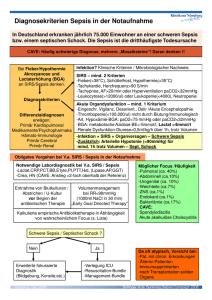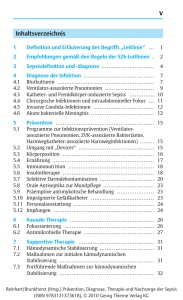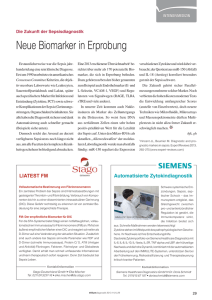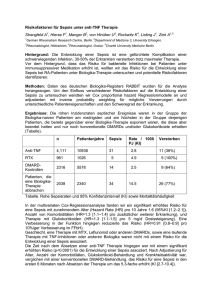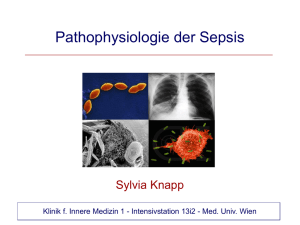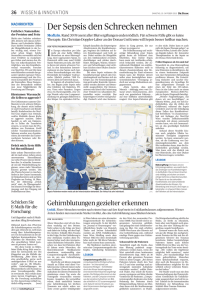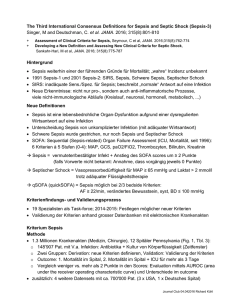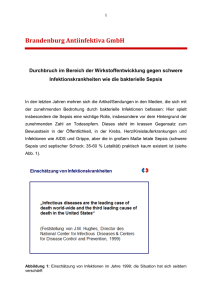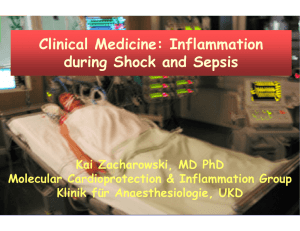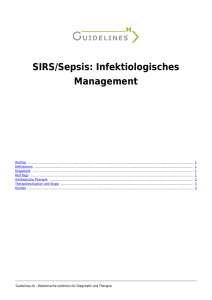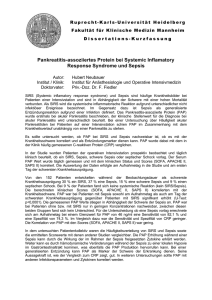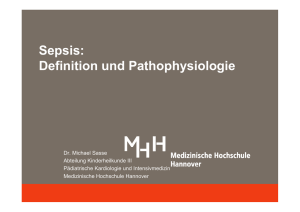Clinical Medicine: Inflammation during Shock and Sepsis
Werbung
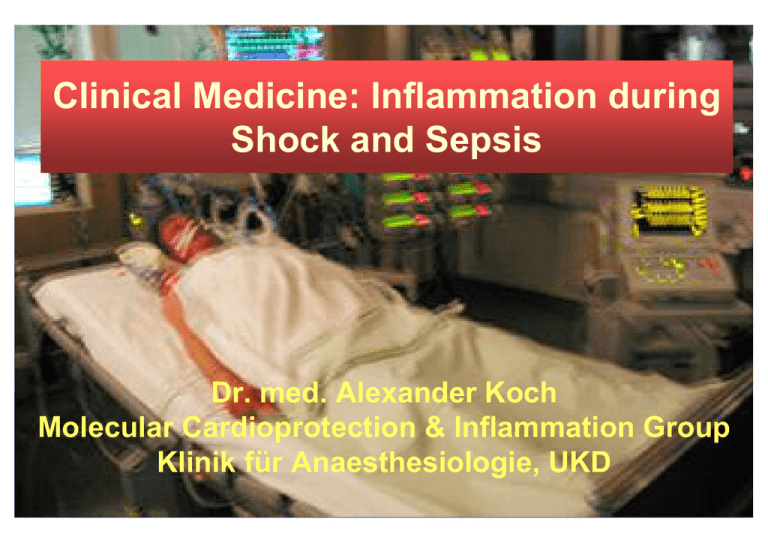
Clinical Medicine: Inflammation during Shock and Sepsis Dr. med. Alexander Koch Molecular Cardioprotection & Inflammation Group Klinik für Anaesthesiologie, UKD Definition Epidemiologie Pathophysiologie Therapie From bench to bed-side Definition Epidemiologie Pathophysiologie Therapie From bench to bed-side Trauma / Inflammation SIRS ohne Infektion Eine klinische Reaktion auf einen nichtspezifischen Insult, die 2 oder mehr der folgenden Symptome aufweist Temp. Herzfreq. Atemfreq. Leukozyten Bone et al. Chest 1992 Sepsis Schwere Sepsis SIRS mit angenommener oder nachgewiesener Infektion > 38°C oder < 36°C > 90/min > 20/min > 12.000 oder < 4000/mm3 oder > 10 % unreife Neutrophile SIRS = Systemic Inflammatory Response Syndrom Trauma / Inflammation SIRS ohne Infektion Sepsis Schwere Sepsis Sepsis mit 1 Organversagen Renal Respiratorisch Hepatisch Hämatologisch ZNS Kardiovaskulär (refraktäre Hypotension) Septischer Schock Bone et al. Chest 1992 Wheeler & Bernard. N Engl J Med 1999 Definition Epidemiologie Pathophysiologie Therapie From bench to bed-side SepNet 2005 www.sepsis-gesellschaft.de In Deutschland - “Blutvergiftung” dritthäufigste Todesursache… - 162 Tote/Tag - Inzidenz: 154.000 www.kompetenznetz-sepsis.de 28-Tage Sterblichkeit SIRS: 10 % Sepsis: 20 % Schwere Sepsis: 20 – 40 % Septischer Schock: 40 – 80 % USA: Haupttodesursache anaesth./chir. ICUs ~ 200.000 Tote/Jahr (~ akuter MI) ~ 17 Milliarden $/Jahr Brun-Buisson C. ICM 2000; Friedman et al. CCM 1998 Krankheitsfälle pro 100.000 Einwohner/Jahr Aids Darm krebs Brustkrebs Sepsis 17 80 112 300 Sepsis: Eine wachsende Herausforderung für das Gesundheitswesen Zukunft Heute >1,5 Millionen Fälle schwerer Sepsis* ~ Sepsisfälle auf der Intensivstation 1995 *OECD = Organization for Economic Cooperation and Development Linde-Zwirble et al. CCM 1999; aus: Opal und Cohen, CCM 1999. Steigende Zahl älterer Mitbürger Lebenserhaltende Technologien Invasive Techniken und Verfahren Ambulant erworbene Infektionen Nosokomiale Infektionen Antibiotika-Resistenz Definition Epidemiologie Pathophysiologie Therapie From bench to bed-side Sepsis-Pathophysiologie Sepsis-Pathophysiologie (ERK) Extrazellulärsignal-regulierte Kinase; (IKK) IK Kinase; (IRAK) Interleukin-1-Rezeptorassoziierte Kinase; (JNK) c-Jun N-terminale Kinase; (LPS) Lipopolysaccharid; (LBP) LPSbindendes Protein; (NF-KB) nukleärer Faktor KB; (SAPK) Stressaktivierte Proteinkinase; (TIRAP) „toll-IL-1R (TIR) domain-containing adapter protein“; (TLR4)Toll-like-Rezeptor 4; (TRAF6) TumorNekrose-Faktor-Rezeptor-assoziierter Faktor 6 Sepsis-Pathophysiologie Sepsis-Pathophysiologie Sepsis Gerinnung Endothelschädigung Fibrinolyse Organversagen Tod Inflammation Gesund vs. Sepsis De Backer et al. AJRCCM 2002 normal Hyperinflammation Immunparalyse Immunstatus Gesunde Person mit Meningokokkeninfektion Älterer Herr mit Divertikulose Patient mit Diabetes, Niereninsuff. und Pneumonie 1 2 3 4 Tage 5 6 7 8 Definition Epidemiologie Pathophysiologie Therapie From bench to bed-side ´Current Concepts´ 1. 1.kausale kausaleantimikrobielle antimikrobielle//operativ-interventionelle operativ-interventionelleHerdsanierung Herdsanierung a 2. 2.ARDS-Beatmung ARDS-Beatmung(12 (12vs vs66ml/kg ml/kgBW): BW):Sterblichkeit Sterblichkeit 39.8 39.8vs vs31.0 31.0(p=0.007) (p=0.007)a 3. 3.EGDT EGDT(early (earlygoal goaldirected directedtherapy): therapy):frühzeitige frühzeitige++aggressive aggressiveOptimierung Optimierungder der b kardiozirkulator. kardiozirkulator.Funktion; Funktion;28-Tage 28-TageLetalität Letalität 46.5 46.5vs vs30.5 30.5(p<0.009) (p<0.009)b 4. 4.Normalisierung NormalisierungBlutzuckers Blutzuckers(80-110 (80-110vs vs-215 -215mg/dl): mg/dl):Sterblichkeit Sterblichkeit 8.0 8.0vs vs4.6 4.6 c (p=0.007) (p=0.007)c 5. 5.relat. relat.NNR-Insuffizienz: NNR-Insuffizienz:Cortisontherapie Cortisontherapiefraglich, fraglich,CORTICUS-Studie CORTICUS-Studiesoll soll Klarheit Klarheitverschaffen verschaffen 6. 6.Aktiviertes AktiviertesProtein ProteinCC a Acute Respiratory Distress Syndrome Network, NEJM 2000 b Rivers et al., NEJM 2001 c Van den Berghe et al., NEJM 2001 Joyce: JBC;276(14):11199 APC – Signifikante Reduktion der Sterblichkeit PROWESS: 28-Tage-Sterblichkeit 1 von 5 Patienten, die verstorben wären, überlebt. Bernard et al. N Engl J Med 2001 Definition Epidemiologie Pathophysiologie Therapie From bench to bed-side S. aureus LTA und PepG-Freisetzung TLR-2 TNFI IL1J IL-6 E. coli LPS-Freisetzung TLR-4 TLRs sind Homologe zum Drosophila-Rezeptorprotein toll. LPS CD14 Mensch 10 verschiedene TLR N Rezeptoren der Innaten Immunity. LTA TLR-2 TLR-4 Makrophage TLR-1 & 6: Corezeptoren für TLR 2 TLR-2: Lipoproteine & Lipopeptide TLR-3: doppelsträngige RNA TLR-4: LPS IL – 1, 2, 6, TNF TLR-5: Flagellin TLR-9: CpG-Motive in bakt. DNA Sepsis Inflammation, Gerinnung , Fibrinolyse , Endothelschaden LPS control TLR-2 TLR-4 control TLR-4-KO liver heart kidney lung liver heart kidney lung J-actin TLR-4-KO Schutz gegen Herzinfarkt ! LTA/LPS Infarct size (% of AR) 75 Herzinfarkt cTnT (ng/ml) 100 75 50 25 0 50 con 2h 4h 8h 16 h 24 h 25 0 con 2h 4h 8h 16 h 24 h Zacharowski et al. ATVB 1999; 2000; Shock 2002 Können wir auch andere Organe “impfen” und damit schützen ? CK O H S SE P SI S SEPS K C O SH IS 24h “low dose” LPS - Gram Schock ALT (IU/l) AST (IU/l) 2000 2000 1500 1500 1000 1000 × 500 500 0 0 sham saline saline LPS LPS LPS × sham saline saline LPS LPS LPS 24h “low dose” LPS AST (IU/l) Gram + Schock ALT (IU/l) 500 500 400 × 400 300 300 200 200 100 100 0 0 sham saline saline LPS LTA/PepG LTA/PepG × sham saline saline LPS LTA/PepG LTA/PepG iNOS/NO: Liver 500 1 0 - 2 300 200 100 0 con 2h 4h 8h 16 h L P S ( 1 m g /k g ) 24 h 1400W 400 - NO3 /NO2 (Pmol/l) (x-fold of control) mRNA induction 3 control 2h 4h 8h LPS (1 mg/kg) 16 h 24 h HO-1: Liver 3 2 1 0 control 2h 4h 8h 16 h L P S (1 m g /k g ) 24 h (x-fold of control) 3 Protein Content (x-fold of control) mRNA induction 4 1400W 2 1 0 con 2h 4h 8h 16 h L P S ( 1 m g /kg ) 24 h PARS ‘Suicide Hypothesis’- Necrosis ly o p P D (A e) s bo i r - he t n y s s ta e oxidant stress (ROS) strand breaks in DNA Activation of PARS NAD depletion of NAD fall in ATP poly (ADP-ribose) nuclear proteins + nicotinamide CELL DEATH pro-inflammatory cytokines cell expressing iNOS Implications for PARS neutrophil activation and tissue infiltration L-Arg iNOS mRNA iNOS Cit e.g. ischemiareperfusion injury and shock O2- O2NO ONOOONOO- NO target cell O2- + NO nucleus ONOOPARS activation mitochondria impaired activity, decreased energy metabolism DNA strand breaks ADP-ribosylation NAD NAm 4 ATP energy failure cell death Chatterjee, Zacharowski et al. FASEBJ 2000 Goldfarb, Marton et al., CCM 2002 Classical Pathway Increased Vascular Permiability Cell Migration (Ag-Ab-Complex) C3a C5a Anaphylatoxins sCR1 sCR1 C3 Activated C3 Alternative Pathway Damaged Tissue Microorganisms Membrane Attack Complex Activated C5 Cell Binding C3b White Cell Adhesion Direct Cell Killing Mechanism of action: sCR1sLex sCR1 sLex binds and inactivates C3b and C4b binds and blocks E- and P-selctin prevention of complement system activation prevention of PMN adhesion (rolling) to the endothelium infla mm atio n Endothelial cells control inflammatory reactions Tethering Rolling Activation Adhesion Migration Zusammenfassung I Klinik Sepsis ist eine lebensbedrohliche Erkrankung – 1 Toter jede Minute Zukunft – mit mehr Sepsisfällen muss gerechnet werden rhAPC – senkt Sterblichkeitsrate bei Patienten mit schwerer Sepsis Research TLRs eröffnen neue therapeutische Möglichkeiten Gezieltes An- und Ausschalten von klassischen “shock genes” Zusammenfassung II Eine Vielzahl von Faktoren bestimmen die Pathophysiologie der Sepsis. Dysbalance – Endothel - Leukozyten: ProAnti-Inflammation Blutgerinnung Fibrinolyse ´Therefore, I believe that we need multiple and combined approaches to treat the killer´
